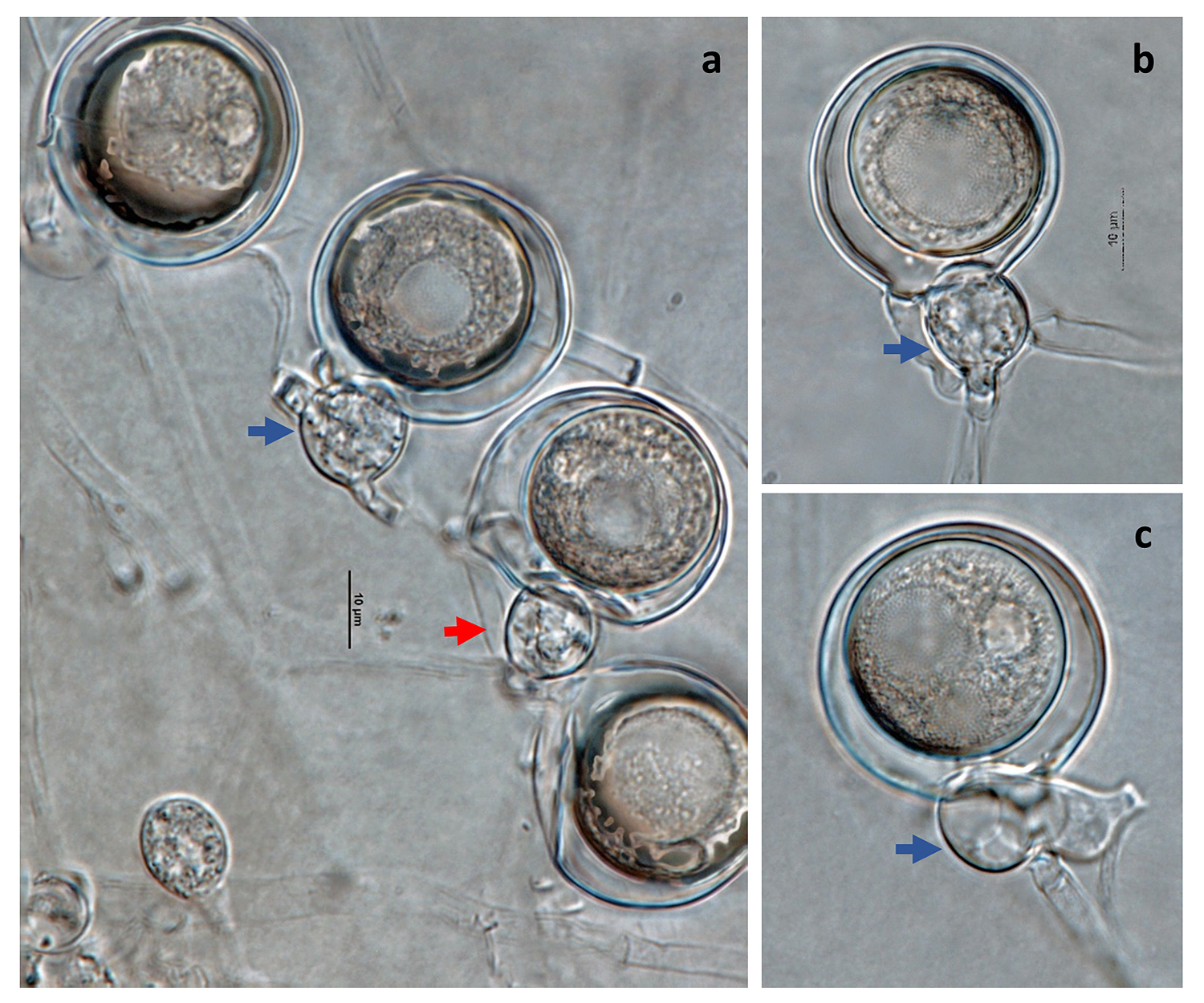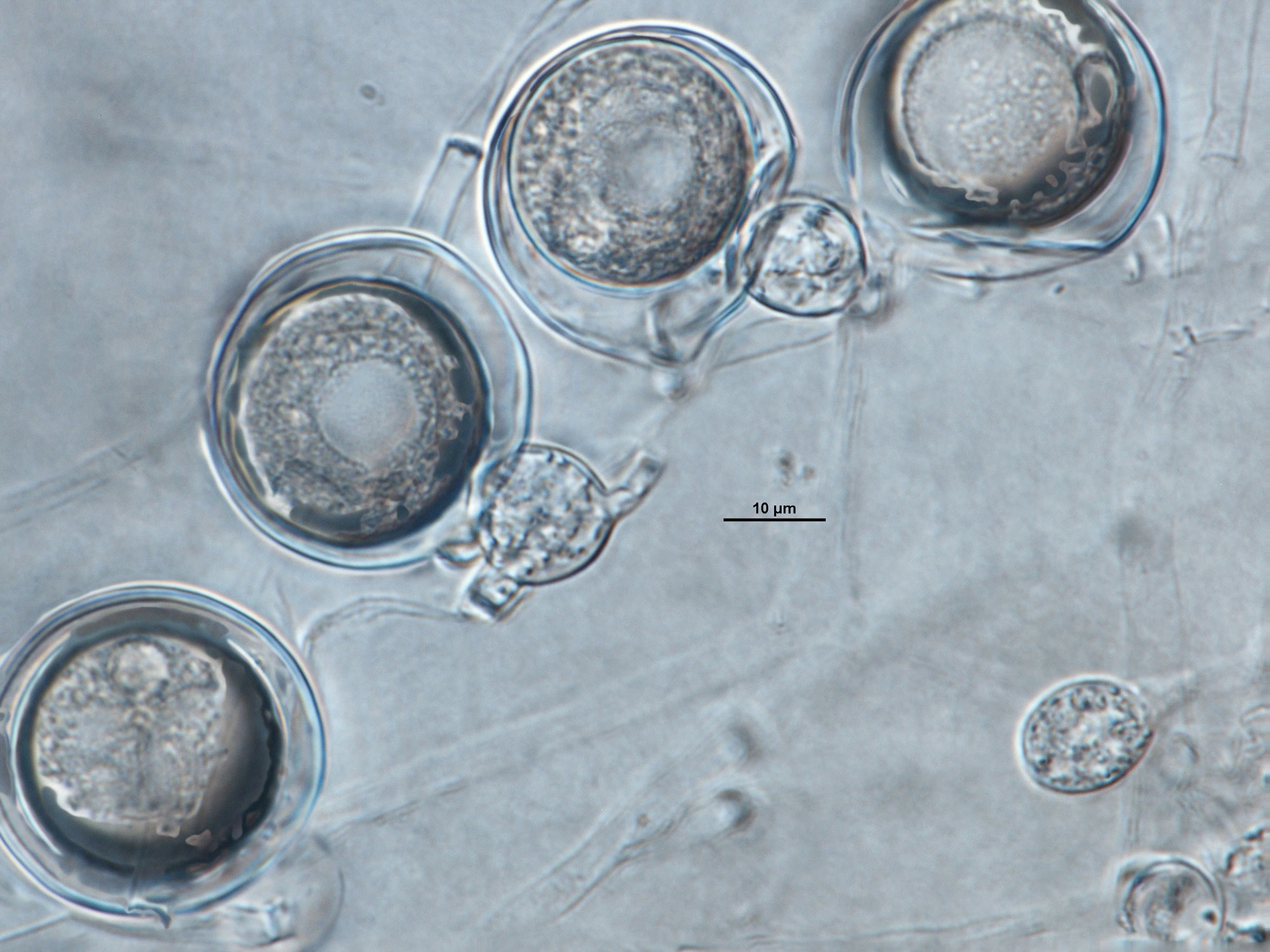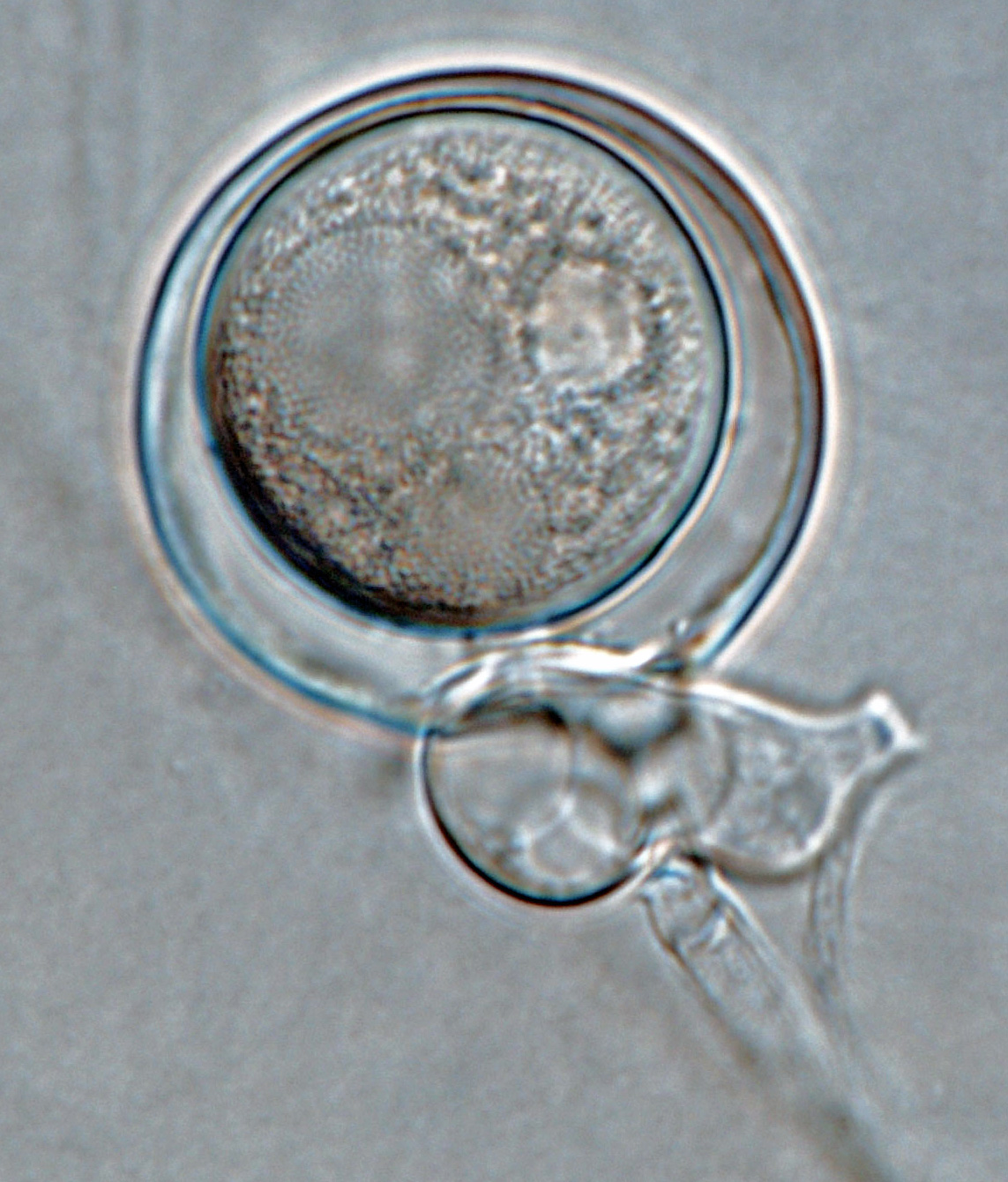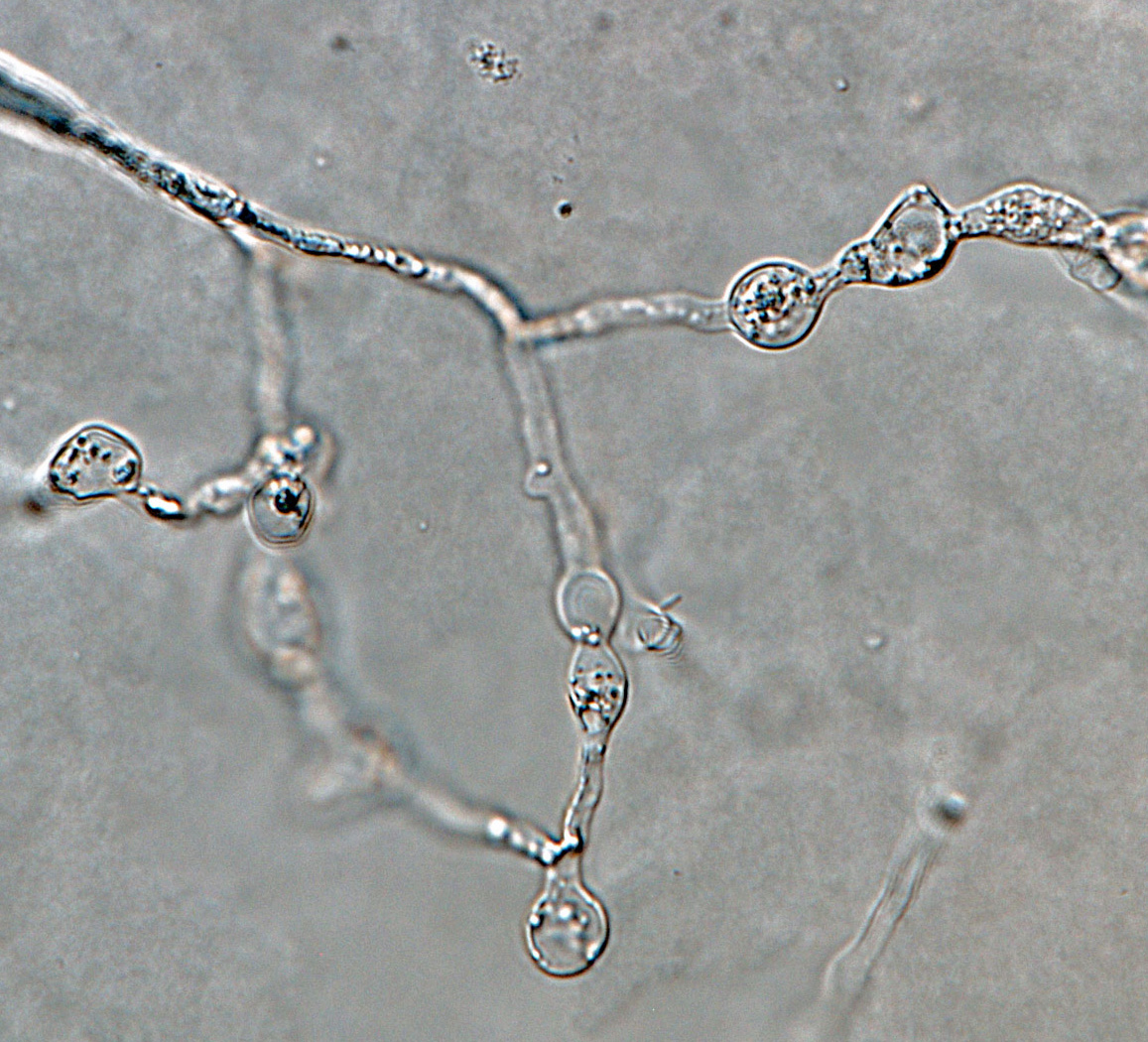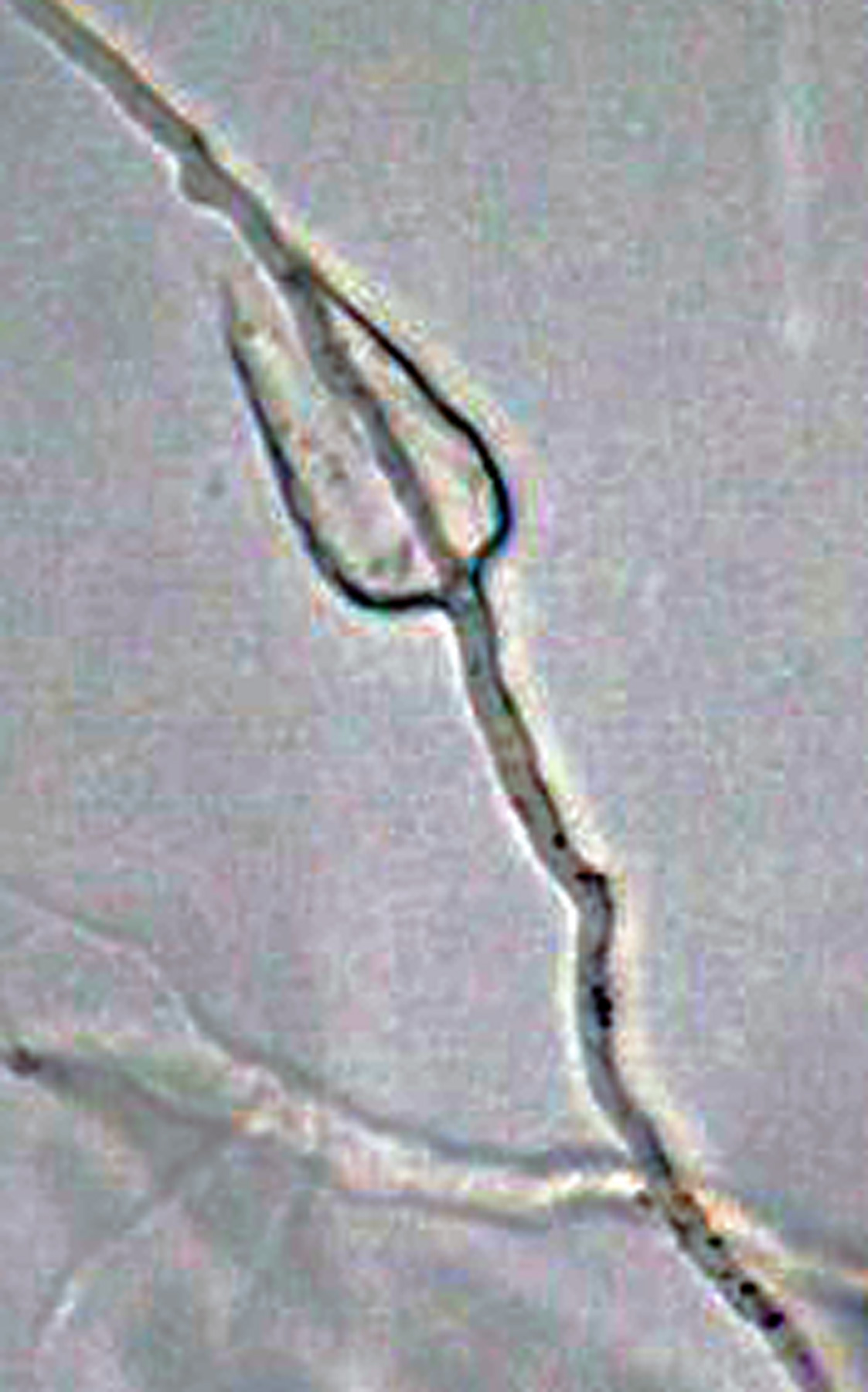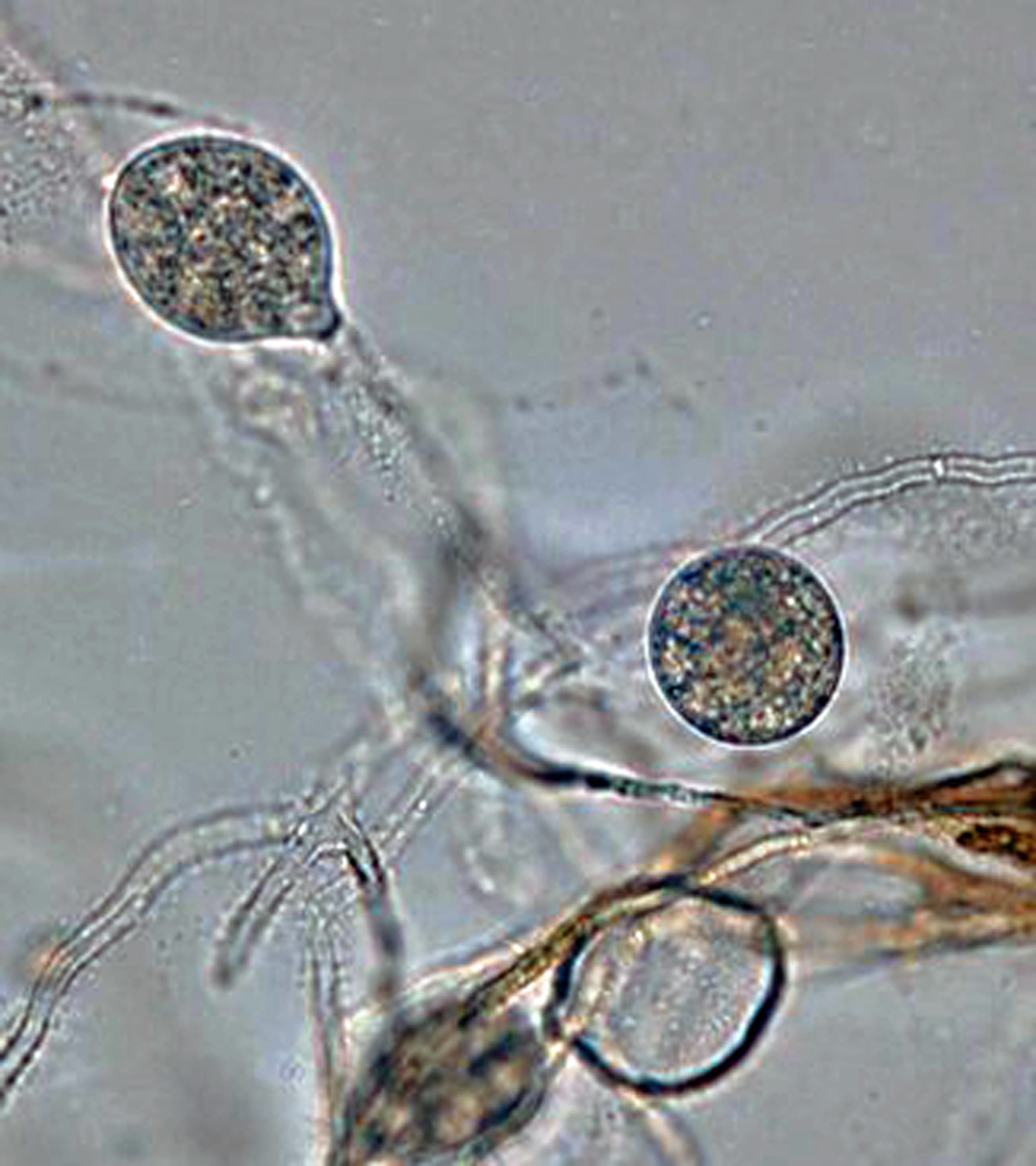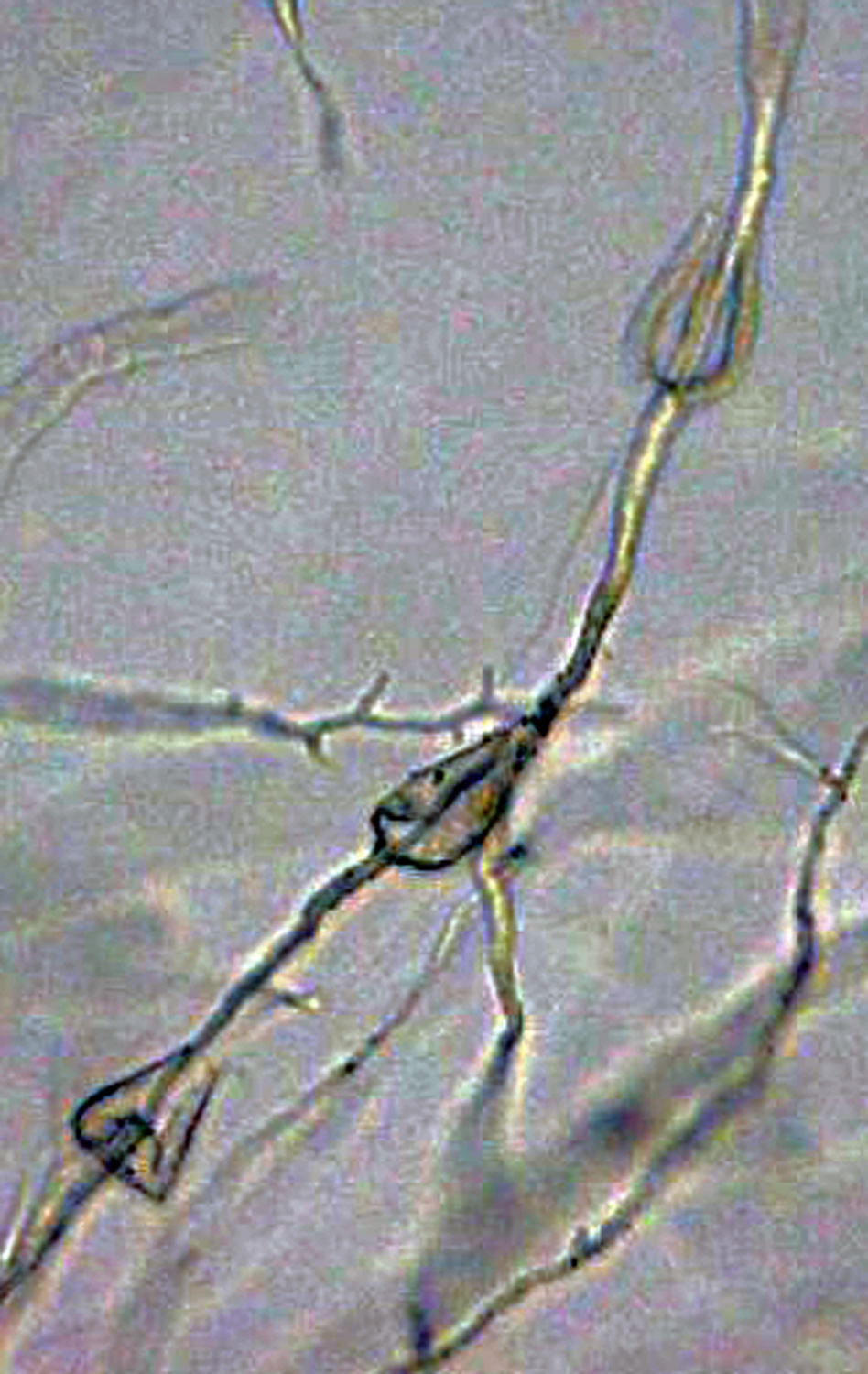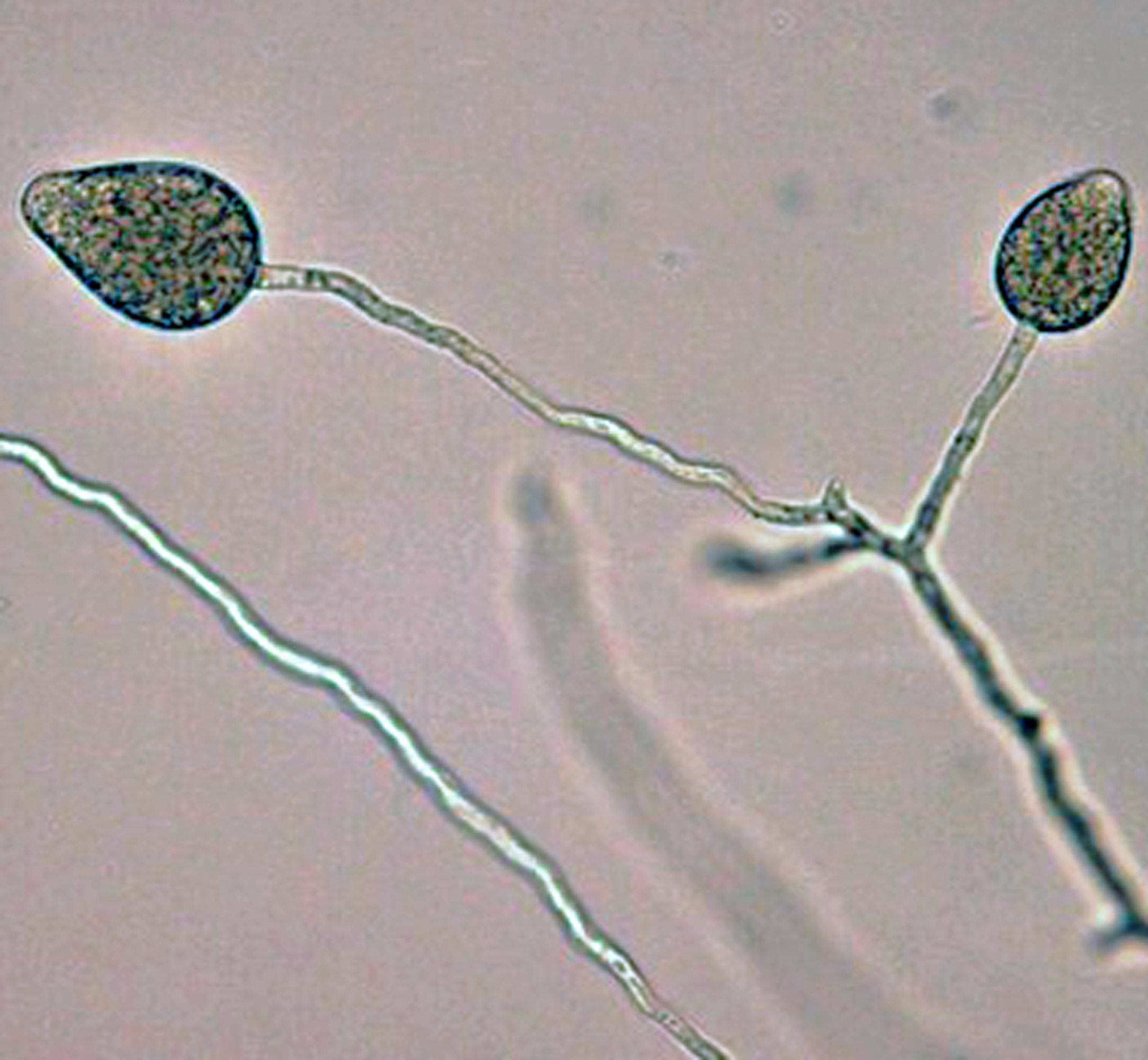Phytophthora lilii
|
Phytophthora spp. in Clade 11: portion of the seven-loci ML phylogeny featuring the type cultures of 212 described species (by T. Bourret). Notice the position of P. lilii Ex-type CBS 135746 = S&T BL 123. Gloria Abad, USDA S&T.
|
|
Phytophthora spp. in Clade 11: Morphological Tabular key (PDF) and Tabular key legends (PDF) in IDphy2 KEY SECTION. Notice the data of P. lilii Ex-type CBS 135746 = S&T BL 123. Gloria Abad, USDA S&T.
|
|
Phytophthora lilli (CPHST BL 123) colonies of the ex-type grown for 7 days on (a) V8® Agar, (b) potato dextrose agar, and (c) malt extract agar; photo by Krysta Jennings and Leandra Knight, USDA-APHIS-PPQ |
|
Phytophthora lilii (ex-type EL-8701 = CBS 135746) colony morphology and temperature requirements; slide provided by Koji Kageyama and Mohammad Z. Rahman Gifu University, Japan |
|
Phytophthora lilii (ex-type CBS 135746) asexual phase: (a–d) sporangia nonpapillate persistent, (b) external proliferation, (c, d) internal proliferation, (e) globose and irregular hyphal swellings, (f) globose chlamydospores; photos by Koji Kageyama and Mohammad Z. Rahman Gifu University, Japan. |
|
Phytophthora lilii (ex-type CPHST BL 123 = CBS 135746) sexual phase: (a–c) smooth-walled oogonia with aplerotic oospores, (blue arrows) paragynous antheridia, (red arrow) amphigynous antheridia rarely produced; photos by Gloria Abad, USDA-APHIS-PPQ. |
|
|
|
Phytophthora lilii (ex-type CPHST BL 123 = CBS 135746) sexual phase: smooth-walled oogonia with aplerotic oospores.Showing paragynous antheridium (middle left) and amphigynous antheridium (middle right) rarely produced; photo by Gloria Abad, USDA-APHIS-PPQ. |
|
Phytophthora lilii (ex-type CPHST BL 123 = CBS 135746) sexual phase: smooth-walled oogonia with aplerotic oospore with paragynous antheridium; photo by Gloria Abad, USDA-APHIS-PPQ. |
|
Phytophthora lilii (ex-type CPHST BL 123 = CBS 135746) sexual phase: smooth-walled oogonia with aplerotic oospore with paragynous antheridium; photo by Gloria Abad, USDA-APHIS-PPQ. |
|
Phytophthora lilii (ex-type CBS 135746) asexual phase: globose and irregular hyphal swellings; photo by Koji Kageyama and Mohammad Z. Rahman Gifu University, Japan. |
|
Phytophthora lilii (ex-type CBS 135746) asexual phase: external proliferation of sporangium; photos by Koji Kageyama and Mohammad Z. Rahman Gifu University, Japan. |
|
Phytophthora lilii (ex-type CBS 135746) asexual phase: internal proliferation of sporangium; photos by Koji Kageyama and Mohammad Z. Rahman Gifu University, Japan. |
|
Phytophthora lilii (ex-type CBS 135746) asexual phase: internal proliferation of sporangium; photos by Koji Kageyama and Mohammad Z. Rahman Gifu University, Japan. |
|
Phytophthora lilii (ex-type CBS 135746) asexual phase: globose chlamydospores; photo by Koji Kageyama and Mohammad Z. Rahman Gifu University, Japan. |
|
Phytophthora lilii (ex-type CBS 135746) asexual phase: internal proliferation of sporangia; photos by Koji Kageyama and Mohammad Z. Rahman Gifu University, Japan. |
|
Phytophthora lilii (ex-type CBS 135746) asexual phase: nonpapillate persistent sporangia; photos by Koji Kageyama and Mohammad Z. Rahman Gifu University, Japan. |
Name and publication
Phytophthora lilii M.Z. Rahman, S. Uematsu, Kimish. & Kageyama (2015)
Rahman MZ, Uematsu S, Kimishima E, Kanto T, Kusunoki M, Motohashi K, Ishiguro Y, Suga H, and Kageyama K. 2015. Two plant pathogenic species of Phytophthora associated with stem blight of Easter lily and crown rot of lettuce in Japan. Mycoscience 56: 419–433 (pg. 424).
Corresponding author: rahman@green.gifu-u.ac.jp
Nomenclature
from Rahman et al. (2015)
Mycobank
Etymology
named after the host plant, Lilium longiflorum (Easter lily)
Typification
Type: JAPAN, Kagoshima, Okinoerabu Island, in stems of Lilium longiflorum, May 1987, leg. E. Kimishima, NBRC H-13200 (freeze dried)
Ex-type: culture, NBRC 32174, MAFF 237500, CBS 135746
Sequences for ex-type in original manuscript: Phytophthora sp. EL-8701 = 60SL10 AB856779, β-tub AB856782, EF1-a AB856788, Eno AB856791, HSP90 AB856794, LSU AB856797, tigA AB856800, cox 1 AB856785
Ex-type in other collections
(ET) CBS 135746, NBRC 32174, MAFF 237500, WPC P19991, S&T BL 123 (Abad)
Molecular identification
Voucher sequences for barcoding genes (ITS rDNA and COI) of the ex-type (see Molecular protocols page)
Phytophthora lilii isolate CPHST BL 123 (= P19991 WPC) = ITS rDNA MG865523, COI MH136918
Voucher sequences for Molecular Toolbox with seven genes (ITS, β-tub, COI, EF1α, HSP90, L10, and YPT1
(see Molecular protocols page) (In Progress)
Voucher sequences for Metabarcoding High-throughput Sequencing (HTS) Technologies [Molecular Operational Taxonomic Unit (MOTU)]
(see Molecular protocols page) (In Progress)
Sequences with multiple genes for ex-type in other sources
- NCBI: Phytophthora lilii CPHST BL 123
- NCBI: Phytophthora sp. EL_8701
- EPPO-Q-bank: Phytophthora lilii
- BOLDSYSTEMS: Phytophthora lilii (barcoding COI & ITS)
Position in multigenic phylogeny with 7 genes (ITS, β-tub, COI, EF1α, HSP90, L10, and YPT1)
Clade clade:
a taxonomic group of organisms classified together on the basis of homologous features traced to a common ancestor
11
Morphological identification
adapted from Rahman et al. (2015)
Colonies and cardinal temperatures
Colony colony:
assemblage of hyphae which usually develops form a single source and grows in a coordinated way
morphology after 7 days of growth on V8 agar, potato dextrose agar, and malt extract agar with no distinctive pattern. Minimum temperature for growth is 5°C, optimum 28°C, and maximum 33°C.
Conditions for growth and sporulation
Oogonia and oosporesoospores:
zygote or thick-walled spore that forms within the oogonium after fertilization by the antheridium; may be long-lived
produced abundantly in single cultures on V8A and CMA.
Asexual phase
SporangiaSporangia:
sac within which zoospores form, especially when water is cooled to about 10°C below ambient temperature; in solid substrates, sporangia usually germinate by germ tubes
nonpapillatenonpapillate:
pertaining to the production of a non-distinct, or inconspicuous, papilla at the distal end of the sporangium (cf. papillate and semipapillate)
; persistentpersistent:
pertaining to sporangia that remain attached to the sporangiophore and do not separate or detach easily (cf. caducous)
; obpyriformobpyriform:
inversely pear-shaped, i.e. with the widest part at the point of attachment (cf. pyriform)
, limoniform, elongated, ellipsoidellipsoid:
refers to a solid body that forms an ellipse in the longitudinal plane and a circle in cross section; many fungal spores are ellipsoidal or elliptic
, ovoidovoid:
egg-shaped, with the widest part at the base of the sporangium and the narrow part at the apex
or distorted (av. 50 long x 29 μm wide); terminal with internal (extended and nesting) and external proliferationexternal proliferation:
formation of a sporangium after a sporangiophore has emerged from beneath and external to an empty sporangium that has previously emitted its zoospores (cf. internal proliferation)
; borne in simple and unbranched or simple sympodial sporangiophores. Hyphal swellings globoseglobose:
having a rounded form resembling that of a sphere
and irregular. ChlamydosporesChlamydospores:
an asexual spore with a thickened inner wall that is delimited from the mycelium by a septum; may be terminal or intercalary, and survives for long periods in soil
globose (34 μm diam.), thin-walled, intercalaryintercalary:
positioned within a hypha (cf. terminal)
.
Sexual phase
Homothallichomothallic:
pertaining to sexual reproduction that can take place within a single thallus (i.e. self-fertile, non-outcrossing) (cf. heterothallic).
. OogoniaOogonia:
the female gametangium in which the oospore forms after fertilization by the antheridium
smooth, spherical, sub-spherical or funnel-shaped (av. 33 μm diam.); antheridiaantheridia:
the male gametangium; a multinucleate, swollen hyphal tip affixed firmly to the wall of the female gametangium (the oogonium)
mostly paragynousparagynous:
pertaining to the sexual stage in which the antheridium is attached to the side of the oogonium (cf. amphigynous)
, rarely amphigynousamphigynous:
pertaining to the sexual stage in which the antheridium completely surrounds the stalk of the oogonium (cf. paragynous)
, regularly spherical or ovoidovoid:
egg-shaped, with the widest part at the base of the sporangium and the narrow part at the apex
ellipsoidellipsoid:
refers to a solid body that forms an ellipse in the longitudinal plane and a circle in cross section; many fungal spores are ellipsoidal or elliptic
in shape, large size equal to oogoniumoogonium:
the female gametangium in which the oospore forms after fertilization by the antheridium
(av. 20 x 15 μm wide); oosporesoospores:
zygote or thick-walled spore that forms within the oogonium after fertilization by the antheridium; may be long-lived
apleroticaplerotic:
pertaining to a mature oospore that does not fill the oogonium; i.e. there is room left between the oospore wall and oogonium wall (cf. plerotic)
, spherical (av. 28 μm diam.).
Most typical characters
Phytophthora lilii is characterized by having hyphal swellings, chlamydosporeschlamydospores:
an asexual spore with a thickened inner wall that is delimited from the mycelium by a septum; may be terminal or intercalary, and survives for long periods in soil
, internal, nested, and extended proliferationextended proliferation:
a type of internal proliferation in which the sporangiophore originates from inside of an empty sporangium, and continues to grow through and out of the old sporangium
of sporangiasporangia:
sac within which zoospores form, especially when water is cooled to about 10°C below ambient temperature; in solid substrates, sporangia usually germinate by germ tubes
with subsequent empty sporangiasporangia:
sac within which zoospores form, especially when water is cooled to about 10°C below ambient temperature; in solid substrates, sporangia usually germinate by germ tubes
and external proliferationexternal proliferation:
formation of a sporangium after a sporangiophore has emerged from beneath and external to an empty sporangium that has previously emitted its zoospores (cf. internal proliferation)
, funnel-shaped oogoniaoogonia:
the female gametangium in which the oospore forms after fertilization by the antheridium
, mostly paragynousparagynous:
pertaining to the sexual stage in which the antheridium is attached to the side of the oogonium (cf. amphigynous)
and intercalaryintercalary:
positioned within a hypha (cf. terminal)
large antheridiaantheridia:
the male gametangium; a multinucleate, swollen hyphal tip affixed firmly to the wall of the female gametangium (the oogonium)
, unique colonycolony:
assemblage of hyphae which usually develops form a single source and grows in a coordinated way
pattern, and high optimal growth temperature.
Additional specimen(s) evaluated
Phytophthora lilii ex-type CPHST BL 123, duplicate of P19991 (World Phytophthora Collection), which is a duplicate of CBS 135746
Hosts and distribution
Distribution: Asia (Japan)
Substrate: stems
Disease note: stem blight
Host: Lilium longiflorum (Liliaceae)
Retrieved January 31, 2018 from U.S. National Fungus Collections Nomenclature Database.
Additional references and links
- SMML USDA-ARS: Phytophthora lilii
- EPPO Global Database: Phytophthora lilii
- Forest Phytophthoras of the world: Phytophthora lilii
- CABI Digital Library: Phytophthora lilii
- Encyclopedia of Life (EOL): Phytophthora lilii
- Index Fungorum (IF): Phytophthora lilii
- Google All Phytophthora lilii
- Google Images Phytophthora lilii
- Google Scholar Phytophthora lilii
Fact sheet author
Z. Gloria Abad, Ph.D., USDA-APHIS-PPQ-S&T Plant Pathogen Confirmatory Diagnostics Laboratory (PPCDL), United States of America.


